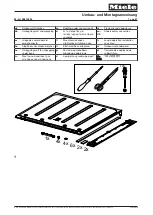
2
PREPARATION
Setting the Channel and Code
The transmitter and receiver are
equipped with two selectable operation
channels and two selectable digital
codes, to ensure positive operation and
prevent interference from similar prod-
ucts nearby. Select the same channel
and code number for both the transmit-
ter and the receiver.
To set the channel, slide
CHANNEL A/B
on the side of the receiver to
A
or
B,
then
set the transmitter’s channel switch
(shown here) to the same setting.
Note: If the door chime occasionally
sounds without anyone pressing
BELL
on the transmitter, change the channel
settings.
To set the code, remove the battery
compartment cover and slide
CODE
to
either
1
or 2 on the receiver, then
set the
transmitter’s code switch to the same
setting.
Connecting the Receiver to AC
Power
Locate a standard AC outlet in the area
where you want to hear the chime and
use the intercom. Plug the receiver's
power cord into the outlet. POWER
lights.
Installing the Transmitter's
Batteries
The transmitter uses four AA batteries
(not supplied) for power. For the best
performance and longest life, we recom-
mend RadioShack alkaline batteries.
Cautions:
• Use only fresh batteries of the re-
quired size and recommended type.
• Do not mix old and new batteries,
different types of batteries (stan-
dard, alkaline, or rechargeable), or
rechargeable batteries of different
capacities.
Follow these steps to install batteries.
1. Use a flat blade screwdriver to
loosen the screw in the transmitter’s
battery compartment cover, then lift
the cover off.
Channel
Code
63-984.fm Page 2 Wednesday, September 8, 1999 4:42 PM















